Zig zag (railway)
A railway zig zag or switchback, is a method of climbing steep gradients with minimal need for tunnels and heavy earthworks.[1] For a short distance (corresponding to the middle leg of the letter "Z"), the direction of travel is reversed, before the original direction is resumed.[2] Not all switchbacks come in pairs, in which case the train may need to travel backwards for a considerable distance.
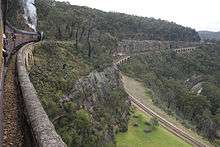
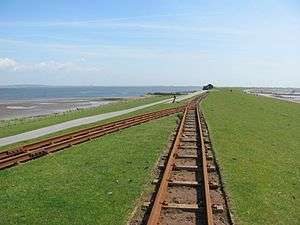
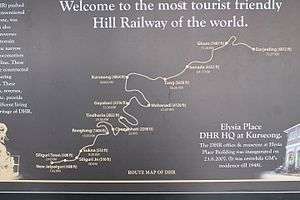
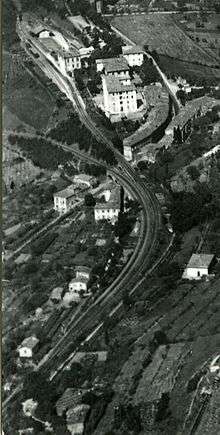
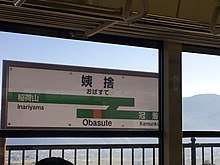

A location on railways constructed by using a zig-zag alignment at which trains have to reverse direction in order to continue is a reversing station.[3]
One of the best examples is the Darjeeling Himalayan Railway, a UNESCO World Heritage site railway in India, that has six full zig zags and three spirals.[4]
Advantages
Zig zags tend to be cheaper to construct because the grades required are discontinuous. Civil engineers can generally find a series of shorter segments going back and forth up the side of a hill more easily and with less grading than they can a continuous grade which has to contend with the larger scale geography of the hills to be surmounted.
Disadvantages
Zig zags suffer from a number of limitations:
- The length of trains is limited to what will fit on the shortest stub track in the zig zag. For this reason, the Lithgow Zig Zag's stubs were extended at great expense in 1908.[5] Even then, delays were such that the zig zag had eventually to be bypassed by a new route, opened two years later.
- Reversing a locomotive-hauled train not purposely equipped for push-pull operation without first running the engine around to the rear of the train can be hazardous – although operating the train with two locomotives, one at each end (a practice known as "topping-and-tailing"), can mitigate the dangers.
- The need to stop the train after each segment, throw the switch, and then reverse means that progress through the zig zag is slow.
Hazards
If the wagons in a freight train are marshalled poorly, with a light vehicle located between heavier ones (particularly with buffer couplings), the move on the middle road of a zig zag can cause derailment of the light wagon.[6]
Examples
- Argentina
- Tren a las Nubes (1921)
- Australia
- Lithgow Zig Zag, New South Wales (1869–1910) preserved - see Zig Zag Railway
- Out of use:
- Kalamunda Zig Zag, Western Australia – two reversals (dismantled)
- Lake Margaret Tram, Tasmania, 610 mm (2 ft) (dismantled)
- Lapstone Zig Zag, New South Wales – two reversals (1865) (dismantled)
- Mundaring Weir Branch Railway, Western Australia (dismantled)
- Thornleigh Zig Zag, New South Wales[7] (dismantled)
- Yarloop, Western Australia (dismantled)
- Yarraglen (dismantled)
- Chile
- Pisagua – Three reversals; long out of use but earthworks easy to trace
- China
- Mifengyan on the Jiayang Coal Railway 762 mm (2 ft 6 in) - one reversal
- Qinglongqiao on the Jingbao Railway
- Denmark
- Lemvig – Small side track from the harbor to the railway station, used only on special occasions. In reality only half a 'Z' as only one reversal is needed.
- Ecuador
- Sibambe on the Quito-Guayaquil line (cf. Empresa de Ferrocarriles Ecuatorianos)
- France
- Germany
- In use:
- Altenkirchen station, Limburg–Altenkirchen railway
- Rauenstein (Hinterland Railway)
- Ernstthal am Rennsteig: created by closure of the Ernstthal–Probstzella railway
- Lauscha (Sonneberg – Probstzella railway)
- Lüttmoorsiel-Nordstrandischmoor island railway
- Michaelstein (Rübeland Railway)
- Rennsteig (Rennsteig Railway, Ilmenau – Themar)
- Wurzbach (Saalfeld – Blankenstein railway)
- out of use
- Lenzkirch in the Black Forest (dismantled)
- Mainspitze station in Frankfurt am Main, used from 1846–1848 to reach the provisional Frankfurt terminal of the Main-Neckar Railway (dismantled)
- Schillingsfürst (dismantled)
- Elm (replaced in 1914 by Distelrasen Tunnel, but the structure is conserved within the Frankfurt-Fulda and Fulda-Gemünden railways and the connecting curve between the stations at Elm and Schlüchtern
- Steinhelle-Medebach railway (double zig zag)
- In use:
- Hungary
- The Szob-Nagybörzsöny forest railway has a simple zig zag at the middle of the railway line between Kisirtás and Tolmács-hegy stations, with a loop in the middle of the Z shape
- India
- Darjeeling Himalayan Railway has six full zig zags and 3 spirals, most are from the construction of the current railway but one was added in the 1940s and at least one other was used temporarily following storm damage
- Italy
- Ferrovia Genova-Casella has one zig zag currently in regular use at Casella Deposito (actually a single reversal)
- Cecina-Volterra railway (this section of the line was closed in 1958)
- the Menaggio–Porlezza railway had a single reversal near Menaggio
- Japan
- Hakone Tozan Line has three zig zags, namely at Deyama S.B., Ōhiradai Station, Kami-Ōhidradai S.B.
- Hisatsu Line at Okoba and Masaki stations
- Hōhi Main Line at Tateno Station
- Kisuki Line at Izumo-Sakane Station
- Keikyu Main Line at Keikyū Kamata Station for trains operating direct service between Yokohama Station and Haneda Airport
- Shinonoi Line Obasute Station in Chikuma, Nagano, is on a switchback
- The Tateyama Sabō Erosion Control Works Service Train (not publicly accessible) is notable for operating on a line with 38 zig zags, 18 of them in a row
- Mexico
- Ferrocarril Noroeste de México, between Juan Mata Ortiz to Chico
- Myanmar (also known as Burma)
- Passenger line between Thazi and Kalaw, with four switchbacks; still in use
- Passenger line between Mandalay and Lashio
- New Zealand
- Driving Creek Railway, Coromandel
- North Korea
- Kanggye Line, between Hwangp'o and Simrip'yŏng stations
- Kŭmgangsan Electric Railway, between Tanballyŏng and Malhwiri (Kŭmganggu) stations. Entire line destroyed during the Korean War and not rebuilt
- Paengmu Line, between Yugok and Rajŏk stations, and at Samyu station (station is located on a single reverse)
- in addition, there are numerous switchbacks on spurs into underground facilities located off main lines.
- Pakistan
- Peru
- PeruRail between Cuzco to Machu Picchu – Five switchbacks
- Seven full Zigzags and one single reverse on the Central Railway of Peru
- Slovakia
- Historical Logging Switchback Railway in Vychylovka
- South Korea
- Yeongdong Line, between Heungjeon station and Nahanjeong station. This section closed in 2012 and replaced by Solan tunnel
- Sweden
- Lövsjöväxeln (Lövsjö points) on Hällefors-Fredriksbergs Järnvägar (1875–1940)[8]
- Switzerland
- Chambrelien: a turntable was required to allow large tender locomotives to be turned as they ran around their trains
- Combe-Tabeillon station on the Saignelégier-Glovelier line
- Grindelwald Grund railway station
- trains on each of the three narrow gauge lines out of Aigle have to reverse somewhere en route (Aigle–Leysin, Aigle–Sépey–Diablerets, Aigle–Ollon–Monthey–Champéry)
- Taiwan
- United States
- Buckingham Branch Railroad, New Canton, Virginia – One switchback at New Canton
- Eight switchbacks at Cascade on GN – Replaced by tunnel which was in turn replaced by a longer tunnel
- Cass Scenic Railroad, West Virginia – Two switchbacks with 11% grade between, still in use
- Colorado and Southern Railway, Central City, Colorado – Two switchbacks on the ascent from Black Hawk, Colorado to Central City
- Confusion Hill Mountain Train Ride, Piercy, California – Several switchbacks in use
- Fern Rock Transportation Center, Fern Rock, Philadelphia - One switchback, connects the Broad Street Line with SEPTA Regional Rail, still in limited use
- Hagans Switchback in Virginia
- Industrial switchback, Montage Mountain Road, Scranton, Pennsylvania – Still in use
- Mount Hood Railroad, Hood River, Oregon – One switchback, still in use
- Northern Pacific's Coeur d'Alene Branch, Lookout Pass – One switchback east of Mullan, Idaho along its 4% descent towards Wallace
- Roaring Camp and Big Trees Narrow Gauge Railroad, Felton, California – One switchback, still in use
- Shasta Sunset Dinner Train, McCloud, California – One switchback, "Signal Butte Switchback", in use
- Sierra Railway, Melones, California - Two switchbacks, abandoned, used by SRY's Angels Branch to cross Stanislaus River Canyon, one switchback inundated by New Melones Lake
References
- Raymond, William G. (1912). "Railway Engineering" (Google books). In Beach, Frederick Converse (ed.). The Americana: A Universal Reference Library, Comprising the Arts and Sciences, Literature, History, Biography, Geography, Commerce, Etc., of the World. 17. New York: Scientific American Compiling Department. Retrieved 3 January 2010.
High mountain levels … may be tunneled … but … may be reached by one of several methods adopted to secure practical grades: (1) Zig-zag development … (2) Switchback development … (3) Spirals or loops …
- Raymond 1912. "Switch-back development … necessitating the use of switches at these ends and the backing of the train up alternate stretches."
- Jackson, Alan A. (2006). The Railway Dictionary (4th ed.). Stroud: Sutton Publishing. p. 285. ISBN 0-7509-4218-5.
- "Mountain Railways of India". UNESCO World Heritage Centre. Retrieved 30 April 2006.
- "The Zig-Zag Deviation". The Dubbo Liberal and Macquarie Advocate (NSW : 1892–1927). NSW: National Library of Australia. 5 December 1908. p. 4. Retrieved 17 February 2013.
- "The Railway Accident on the Zig-zag". Bathurst Free Press and Mining Journal (NSW : 1851–1904). NSW: National Library of Australia. 10 April 1895. p. 3. Retrieved 19 February 2013.
- "Historical and Archaeological Assessment of Proposed Cycleway, Near Thornleigh Quarry, Via De Saxe Close, Thornleigh (Berowra Valley Regional Park), N.S.W." (PDF). The construction of the railway siding and zig-zag to the quarry and also Hall’s Camp were associated with Amos & Co, who won the contract to build the section of railway from Strathfield to Hawkesbury River. Edward Higginbotham & Associates PTY LTD. March 2002. Retrieved 19 November 2017.
- "Bang rdsskisser SVJ/HFJ". www.ekeving.se.